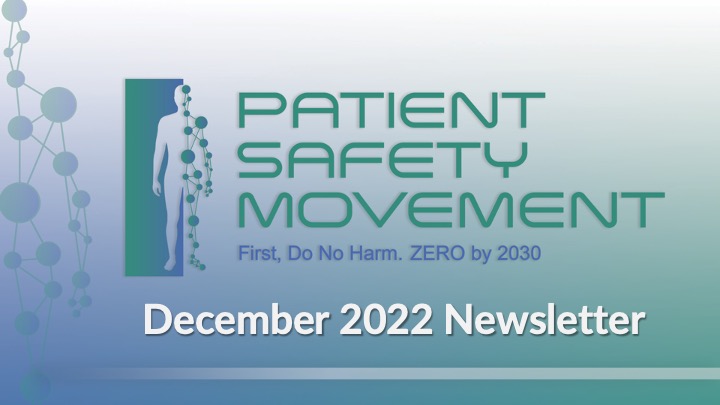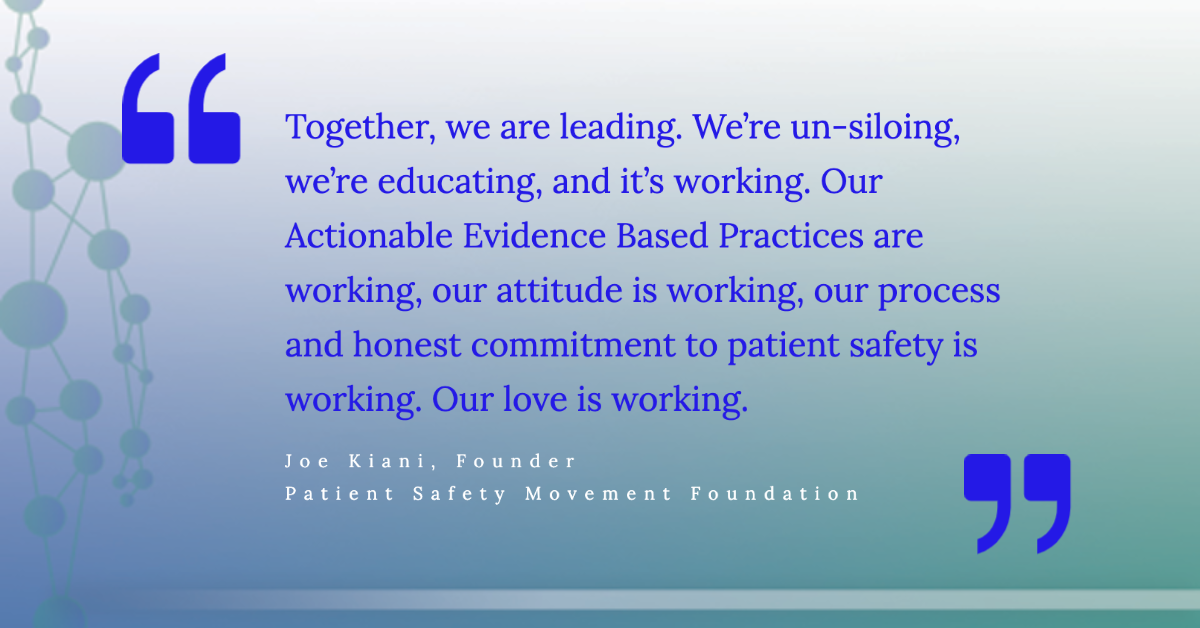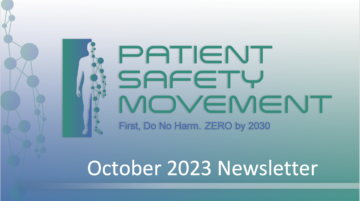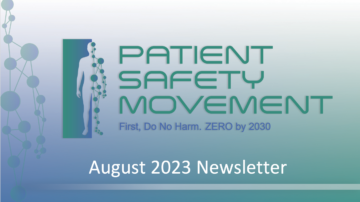2022 – A PIVOTAL YEAR
As we end 2022 and welcome 2023, we are excited at the possibilities a new year brings. There were several key changes this year for the Patient Safety Movement Foundation. I took on the role of Chief Executive Officer as Dr. Mike Durkin became Chairman. Dr. Sanaz Massoumi joined us as the Chief Operating Officer. Along with our Founder, Joe Kiani, we are laser focused on achieving a safer healthcare system, with zero preventable harm—both for patients and clinicians. We even changed our tagline: “First Do No Harm: Zero by 2030.”
Our goals for 2023 are aimed at four major targets:
- Actionable Evidence-Based Practices to reduce common causes of preventable patient harm.
- Transparency of Data—Let’s publish annually the real amount of preventable harm and mortality occurring in healthcare. This will lead to immediate improvement!
- Aligned Incentives—Payment for quality of care, not volume of care.
- Creation of an independent National Patient Safety Board to investigate major causes of preventable harm and publish solutions.
We have been collaborating with people and organizations around the world to rapidly reduce preventable harm and death. This includes the World Health Organization, government agencies, politicians, industry people, healthcare organizations, clinicians, patients, and caring citizens.
We have seen astounding successes by committed healthcare organizations in reducing preventable harm. They are showing us that zero is possible. To make sure we reach all hospitals, we need you on this journey with us. Over 92% of every dollar donated to the Foundation is spent on patient safety programs. We hope you will consider supporting the Patient Safety Movement Foundation.
In Health,

Michael A.E. Ramsay, MD, FRCA
CLEAN HANDS COUNT

The pandemic drew an incredible amount of public attention to the importance of hand hygiene. However, hospital-acquired infections are actually on the rise since the pandemic, according to the CDC, as healthcare workers are still washing or desanitizing their hands less than they should.
Depending on the number of patients they see, clinicians should wash their hands about 100 times in a 12-hour shift. Yet recent studies have found that nurses only complied with handwashing procedures 42% of the time and physicians only 38% of the time. While hand hygiene became part of virtually every business activity during the pandemic, its paramount that healthcare workers continue to adhere to recommended practices to avoid transmission of dangerous pathogens.
In response to this growing concern, the CDC earlier this year launched a Clean Hands Count campaign to highlight ways to improve hand hygiene practices, dispel common myths and misperceptions, and inform patients of the role they play in their own care. According to the CDC:
- Alcohol-based hand sanitizer kills most of the bad germs that make you sick and is the preferred way to clean your hands in healthcare settings.
- Alcohol-based hand sanitizer does not kill C. difficile, a common healthcare-associated infection. Patients with C. difficile should wash their own hands with soap and water and make sure their healthcare providers always wear gloves when caring for them.
- Alcohol-based hand sanitizer is more effective and less drying than using soap and water, and it does not create antibiotic-resistant superbugs.
- Hand hygiene should be a topic of conversation between healthcare providers and patients. Healthcare providers can explain how and why they clean their hands before, after, and sometimes during patient care, and let patients know it’s ok to ask about hand hygiene.
- Patients and their visitors can protect themselves by cleaning their own hands often.
To learn more, visit the CDC’s Clean Hands Count for Safe Healthcare page.
SUPPORT NPSB LEGISLATION
One of our primary organizational aims, the establishment of a National Patient Safety Board, is gaining momentum at the federal level in a huge way. But we need your help. Congressional Representative Nanette Barragán has introduced bill H.R.9377 – The National Patient Safety Board Act. Please help by clicking here to fill out a simple form to email your representative.
The goal of the National Patient Safety Board (NPSB) is to prevent and reduce patient safety events in healthcare settings. As a non-punitive, collaborative, independent agency, the NPSB is modeled after the National Transportation Safety Board (NTSB) and the Commercial Aviation Safety Team (CAST). Its goal is to dramatically improve the understanding of major sources of harm and bring everyone together to create solutions.
The NPSB would also have a public-private partnership team, the Healthcare Safety Team, to gain consensus on patient safety measures, autonomous data collection technologies, and solutions. To identify and anticipate major sources of harm, the NPSB would not require additional data submission by healthcare providers and would not rely on voluntary reports of patient safety events. Rather, through the Healthcare Safety Team, the NPSB would help public and private entities adopt patient safety data surveillance technologies—automated systems with AI algorithms—to capture Big Data and relieve the burden of data collection at the frontline, while also detecting pre-cursors to harm.
The landmark legislation would significantly improve safety for patients and healthcare providers. Learn more about the National Patient Safety Board at npsb.org.
PUBLIC COMMENT PERIOD OPEN ON HHS ALLIANCE
HHS’s Agency for Healthcare Research and Quality is seeking public comments on how it can best support the advancement of patient and healthcare worker safety as part of its new Action Alliance. Anyone—from health system leaders and clinicians to patients and families—is invited to provide feedback on how the new National Healthcare System Action Alliance to Advance Patient Safety, launching in 2023, can be most effective.
HHS announced its plans for the alliance last November and held a listening session with leaders from some of the nation’s largest systems. The following questions that participants responded to are part of the current request for public comment:
- What are the main challenges your system is facing in meeting your commitments to advancing patient safety as you emerge from the pandemic?
- What can HHS bring to the Action Alliance in terms of coordination, alignment, tools, training, and nonfinancial resources to support the effectiveness of the Action Alliance in assisting healthcare delivery systems in advancing patient and healthcare worker safety?
- How can the Action Alliance most effectively support your organization in advancing patient safety? Are there specific priorities for your system or settings of care?
Click here to submit your comments through January 26, when the public comment period closes.
MEET THE AUTHOR
In this interview, David Mayer, MD, Executive Director of MedStar Institute for Quality and Safety, relates his experience walking to all 30 Major League Baseball ballparks to promote patient safety. His new book How to Stay Safe When Entering the Healthcare System follows his 2,452-mile trek to garner media attention for his mission and indulge his love of baseball.
MEET CHOC CEO
Kimberly Cripe, President & CEO of Children’s Hospital of Orange County (CHOC), discusses how her hospital has incorporated Actionable Evidence-Based Practices to improve patient safety in a pediatric setting, along with the myriad benefits to the bottom line and staff morale. For her and her staff, fostering a culture of safety is a way of life at a children’s hospital.
CHAIRMAN’S COLUMN
 Dear Friends,What a year we have had, as we begin to emerge from the enormity of pressure placed on our health services.
Dear Friends,What a year we have had, as we begin to emerge from the enormity of pressure placed on our health services.
As we gather with our friends and family, let us remember those who are no longer with us due to a preventable medical error. For those families, the holidays are just one more reminder of their deep loss.
We must stay steadfast in our goal to reach zero patient harm in all healthcare settings and environments. At the same time, we must eliminate any harm to our healthcare workers. We have the methods, the tools, and the techniques to produce highly reliable, resilient, and safe healthcare. But do we have the inner drive, the ethical values, and the will to do everything we can to give the right care at the right time in the right way?
A special thank you to those providing us ongoing funding. We could not do what we do without you. We are currently preparing for our next Summit. In 2023, it will be our first in-person Summit since 2019. It will be held in Newport Beach, California, and promises to be the best yet, as we bring together patients, practitioners, politicians, and the science and technology industry to discuss how we will work together to eliminate harm. We look forward to meeting you there.
My thoughts and prayers are with you, and I wish you and yours a 2023 filled with much health, love, joy, peace, and zero preventable harm.
Yours,

Mike Durkin, OBE, MBBS, FRCA, FRCP, DSC
IN THE NEWS
- In an article titled “Address ‘Plane-Crash Level’ Patient Harm, HHS Tells Hospitals,” Forbes reported that HHS Secretary Xavier Becerra stated, “We’re losing pretty much an airline full of Americans every day to medical error,” at a recent meeting of senior health system leaders.
- Brecker’s Hospital Review revealed what the top safety priorities are in 2023 for The Leapfrog Group’s “Straight A” hospitals. Among them are focusing on hospital-acquired infections, which are on the rise, and adding diversity, equity, and inclusion strategies.
- A commentary in NEJM Catalyst | Innovations in Care Delivery highlighted declines in patient safety performance during the COVID-19 pandemic and made recommendations to correct the problems.
- A blog article posted by the Agency for Healthcare Research and Quality argued that “In Pandemic’s Wake, We Must Recommit to Patient and Workforce Safety.”
- In the UK, nurses are driving conversations about strike action among healthcare workers, with patient safety among their primary concerns, according to an analysis of social media posts shared with Nursing Times.
- The 15-year-old daughter of CNN’s Jake Tapper, Alice Tapper, relates a missed appendicitis diagnosis by a Philadelphia hospital last year that nearly cost her her life. She discovered appendicitis is missed in up to 15% of children at initial presentation.

DONOR TESTIMONIALS — WHY I GIVE

We are extremely grateful to supporters like Bernadette Henrichs. Not only does she make monthly financial contributions to the Patient Safety Movement Foundation, she dedicates her time and talents in many other significant ways to further our mission to achieve ZERO patient harm. Bernadette is the Director of the Nursing Anesthesia Program at Goldfarb School of Nursing at Barnes-Jewish College and as Director of CRNA Education and Research at Washington University’s Department of Anesthesiology in Saint Louis.

DONATE TODAY
GOVERNANCE BOARD
Mike Durkin, OBE, MBBS, FRCA, FRCP, DSC, Chairman of PSMF, Senior advisor on Patient Safety Policy and Leadership, Institute of Global Health Innovation, Imperial College London
Steven J. Barker, PhD, MD, Chief Science Officer, Masimo Corporation, Professor Emeritus of Anesthesiology, University of Arizona Health Sciences
Robin Betts, RN, CPHQ, MBA-HA, Vice Chair, PSMF, Vice President, Safety Quality & Regulatory Services, Kaiser Foundation Hospitals and Health Plan, Kaiser Permanente Northern California
Alicia Cole, Patient Safety Consultant
Javier T. Davila, MD, MFS, Ambassador, PSMF in Mexico, Former Medical Director, Mexican Social Security Institute, Head of Medical Education, Research and Health Public Policy
Omar Ishrak, PhD, Executive Chairman and Chairman of the Board of Directors, Medtronic, Chairman of the Board of Directors, Intel
Philip D. Lumb, MB, BS, MD, MCCM, FCCP, Professor of Anesthesiology and Trauma Surgery, Keck School of Medicine at University of Southern California
Joe Kiani, Founder and Immediate Past Chairman of PSMF, Founder, Chairman & CEO of Masimo
Sarah Kiani, Director, Masimo Foundation for Ethics, Innovation, and Competition
David B. Mayer, MD, Executive Director, MedStar Institute for Quality and Safety
Jannicke Mellin-Olsen, MD, DPH, Past President, World Federation of Societies of Anesthesiologists
Jim Messina, CEO, The Messina Group
Najmedin Meshkati, Ph.D, MS, Professor of Civil/Environmental Engineering, University of Southern California
Charlie Miceli, CPM, Treasurer, PSMF, Chief Supply Chain Officer, Network VP of University of Vermont Health Network
Michael A.E. Ramsay, MD, FRCA, Chief Executive Officer, PSMF
Abbasseh Towfigh, MPD, Executive Director and Secretary, Ayeneh Foundation
Vonda Vaden Bates, Patient Advocate, CEO, 10th Dot
OUR STORY

In 2012, Joe Kiani founded the nonprofit Patient Safety Movement Foundation (PSMF) to eliminate preventable medical errors in hospitals. His team worked with patient safety experts from around the world to create Actionable Evidence-Based Practices (AEBP) that address the top challenges. The AEBP is available without charge to hospitals online.
Hospitals are encouraged to make a formal commitment to ZERO preventable deaths, and healthcare technology companies are asked to sign the Open Data Pledge to share their data so that predictive algorithms that can identify errors before they become fatal can be developed. The Foundation’s annual World Patient Safety, Science & Technology Summit brings together all stakeholders, including patients, healthcare providers, medical technology companies, government employers, and private payers. The PSMF was established through the support of the Masimo Foundation for Ethics, Innovation, and Competition in Healthcare. For more information, please visit psmf.org.
![]()








